2011 BMW 550I XDRIVE GRAN TURISMO load capacity
[x] Cancel search: load capacityPage 148 of 297
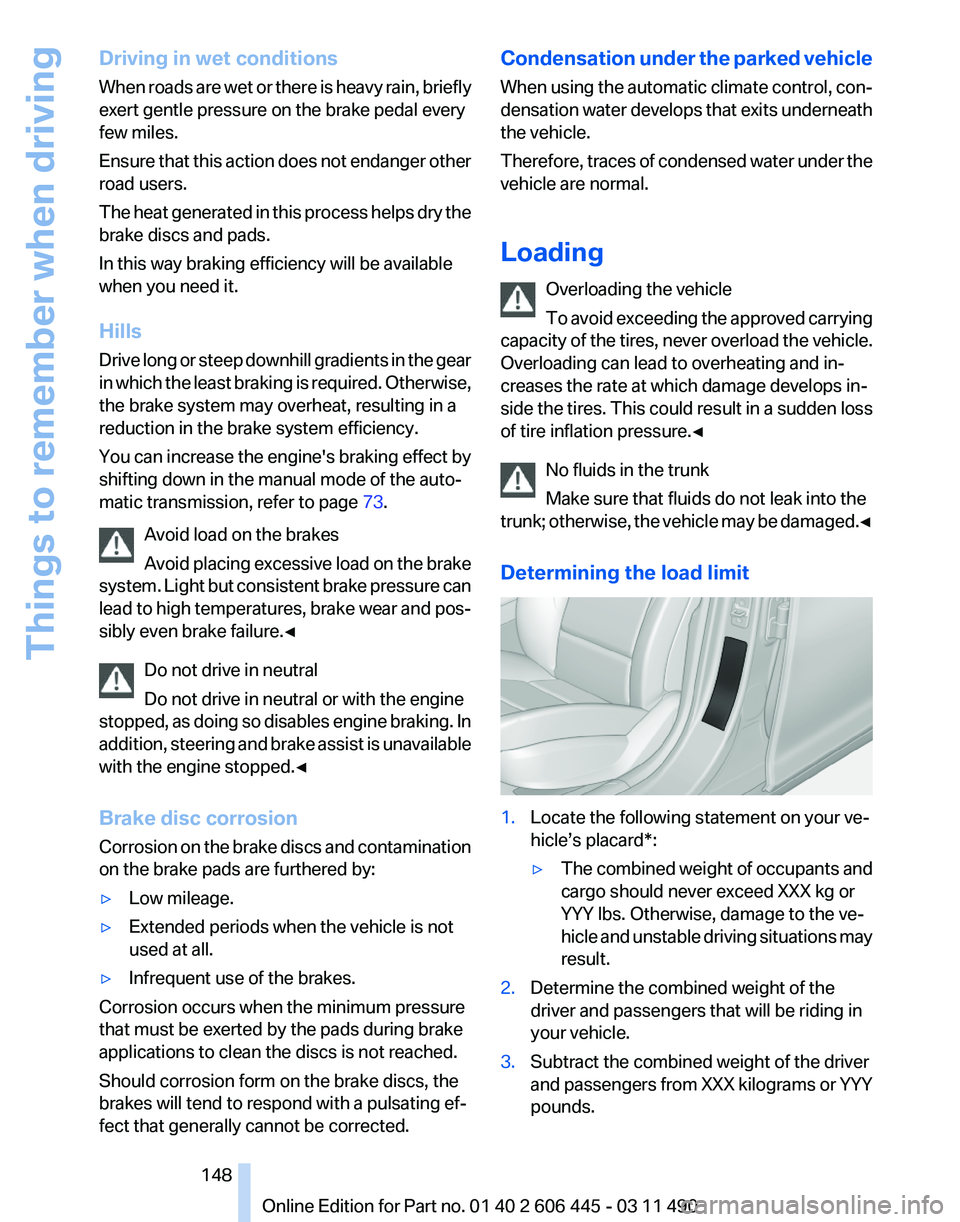
Driving in wet conditions
When
roads are wet or there is heavy rain, briefly
exert gentle pressure on the brake pedal every
few miles.
Ensure that this action does not endanger other
road users.
The heat generated in this process helps dry the
brake discs and pads.
In this way braking efficiency will be available
when you need it.
Hills
Drive long or steep downhill gradients in the gear
in which the least braking is required. Otherwise,
the brake system may overheat, resulting in a
reduction in the brake system efficiency.
You can increase the engine's braking effect by
shifting down in the manual mode of the auto‐
matic transmission, refer to page 73.
Avoid load on the brakes
Avoid placing excessive load on the brake
system. Light but consistent brake pressure can
lead to high temperatures, brake wear and pos‐
sibly even brake failure.◀
Do not drive in neutral
Do not drive in neutral or with the engine
stopped, as doing so disables engine braking. In
addition, steering and brake assist is unavailable
with the engine stopped.◀
Brake disc corrosion
Corrosion on the brake discs and contamination
on the brake pads are furthered by:
▷ Low mileage.
▷ Extended periods when the vehicle is not
used at all.
▷ Infrequent use of the brakes.
Corrosion occurs when the minimum pressure
that must be exerted by the pads during brake
applications to clean the discs is not reached.
Should corrosion form on the brake discs, the
brakes will tend to respond with a pulsating ef‐
fect that generally cannot be corrected. Condensation under the parked vehicle
When
using the automatic climate control, con‐
densation water develops that exits underneath
the vehicle.
Therefore, traces of condensed water under the
vehicle are normal.
Loading
Overloading the vehicle
To avoid exceeding the approved carrying
capacity of the tires, never overload the vehicle.
Overloading can lead to overheating and in‐
creases the rate at which damage develops in‐
side the tires. This could result in a sudden loss
of tire inflation pressure.◀
No fluids in the trunk
Make sure that fluids do not leak into the
trunk; otherwise, the vehicle may be damaged.◀
Determining the load limit 1.
Locate the following statement on your ve‐
hicle’s placard*:
▷The combined weight of occupants and
cargo should never exceed XXX kg or
YYY lbs. Otherwise, damage to the ve‐
hicle
and unstable driving situations may
result.
2. Determine the combined weight of the
driver and passengers that will be riding in
your vehicle.
3. Subtract the combined weight of the driver
and
passengers from XXX kilograms or YYY
pounds. Seite 148
148 Online Edition for Part no. 01 40 2 606 445 - 03 11 490
Things to remember when driving
Page 149 of 297
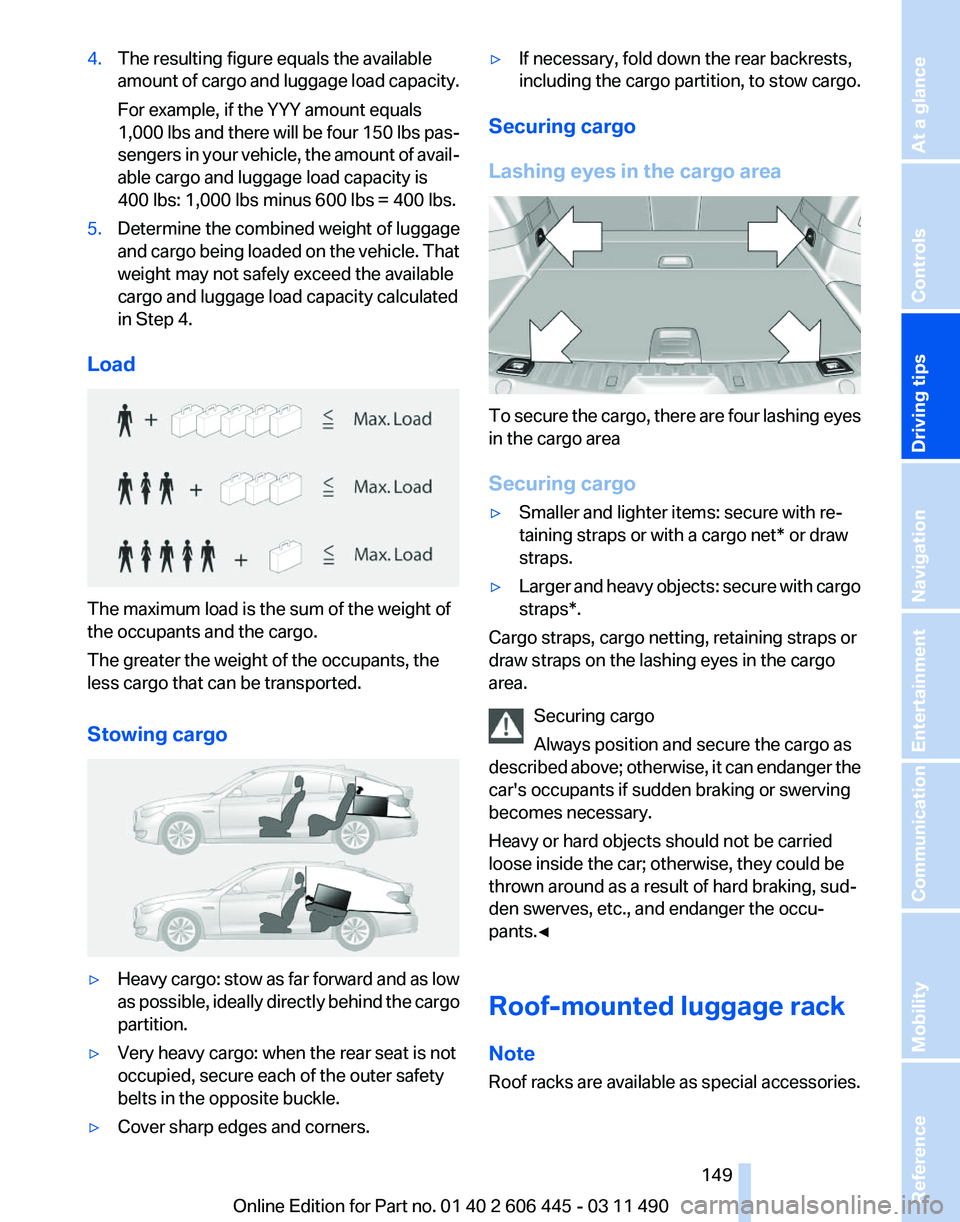
4.
The resulting figure equals the available
amount
of cargo and luggage load capacity.
For example, if the YYY amount equals
1,000 lbs and there will be four 150 lbs pas‐
sengers in your vehicle, the amount of avail‐
able cargo and luggage load capacity is
400 lbs: 1,000 lbs minus 600 lbs = 400 lbs.
5. Determine the combined weight of luggage
and
cargo being loaded on the vehicle. That
weight may not safely exceed the available
cargo and luggage load capacity calculated
in Step 4.
Load The maximum load is the sum of the weight of
the occupants and the cargo.
The greater the weight of the occupants, the
less cargo that can be transported.
Stowing cargo
▷
Heavy cargo: stow as far forward and as low
as
possible, ideally directly behind the cargo
partition.
▷ Very heavy cargo: when the rear seat is not
occupied, secure each of the outer safety
belts in the opposite buckle.
▷ Cover sharp edges and corners. ▷
If necessary, fold down the rear backrests,
including the cargo partition, to stow cargo.
Securing cargo
Lashing eyes in the cargo area To secure the cargo, there are four lashing eyes
in the cargo area
Securing cargo
▷
Smaller and lighter items: secure with re‐
taining straps or with a
cargo net* or draw
straps.
▷ Larger and heavy objects: secure with cargo
straps*.
Cargo straps, cargo netting, retaining straps or
draw straps on the lashing eyes in the cargo
area.
Securing cargo
Always position and secure the cargo as
described
above; otherwise, it can endanger the
car's occupants if sudden braking or swerving
becomes necessary.
Heavy or hard objects should not be carried
loose inside the car; otherwise, they could be
thrown around as a result of hard braking, sud‐
den swerves, etc., and endanger the occu‐
pants.◀
Roof-mounted luggage rack
Note
Roof racks are available as special accessories. Seite 149
149Online Edition for Part no. 01 40 2 606 445 - 03 11 490
Reference Mobility Communication Entertainment Navigation
Driving tips Controls At a glance
Page 275 of 297
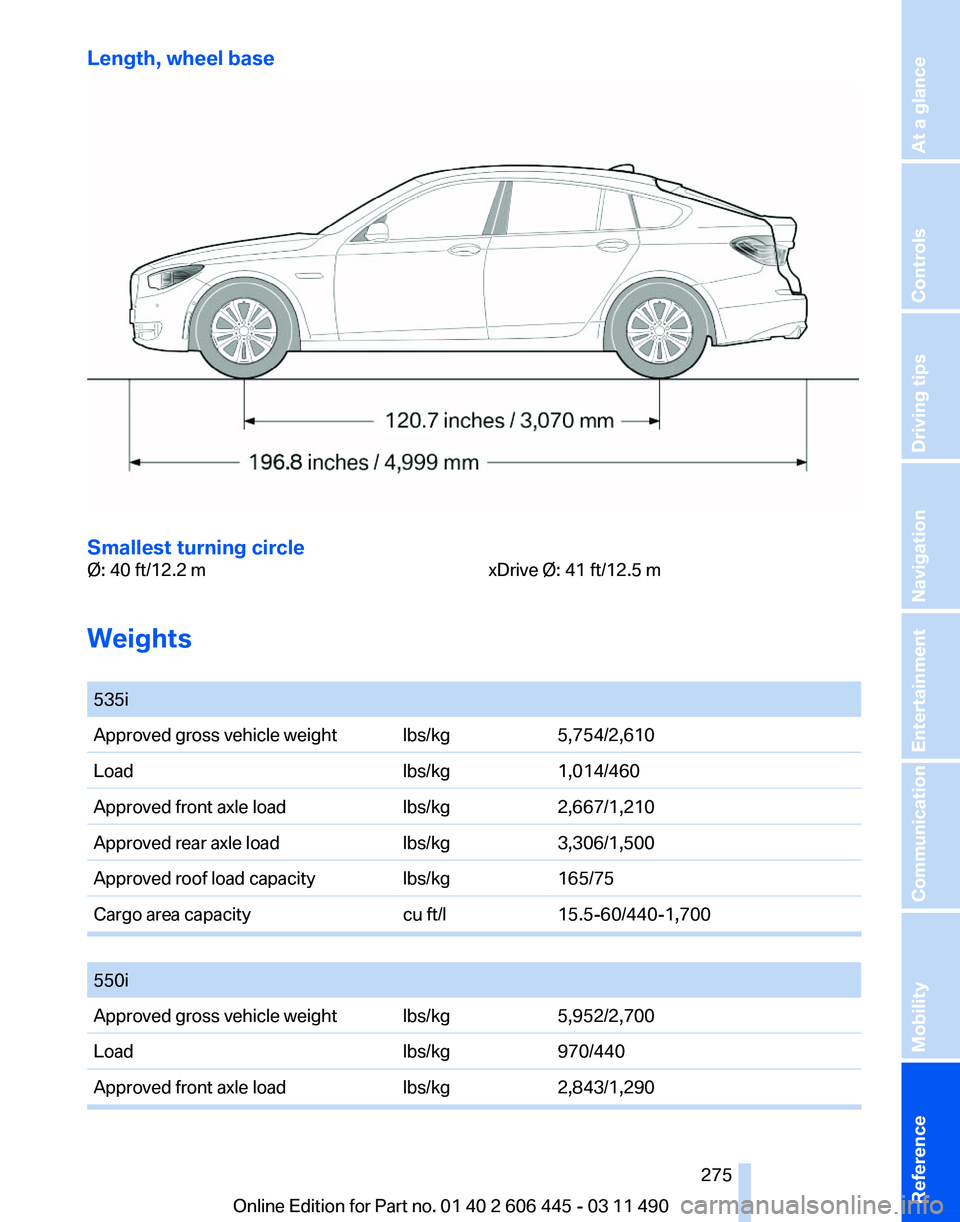
Length, wheel base
Smallest turning circle
Ø: 40 ft/12.2 m
xDrive Ø: 41 ft/12.5 m
Weights
535i
Approved gross vehicle weight lbs/kg
5,754/2,610
Load lbs/kg1,014/460
Approved front axle load lbs/kg2,667/1,210
Approved rear axle load lbs/kg3,306/1,500
Approved roof load capacity lbs/kg165/75
Cargo area capacity cu ft/l15.5-60/440-1,700
550i
Approved gross vehicle weight lbs/kg
5,952/2,700
Load lbs/kg970/440
Approved front axle load lbs/kg2,843/1,290 Seite 275
275Online Edition for Part no. 01 40 2 606 445 - 03 11 490
Reference Mobility Communication Entertainment Navigation Driving tips Controls At a glance
Page 276 of 297
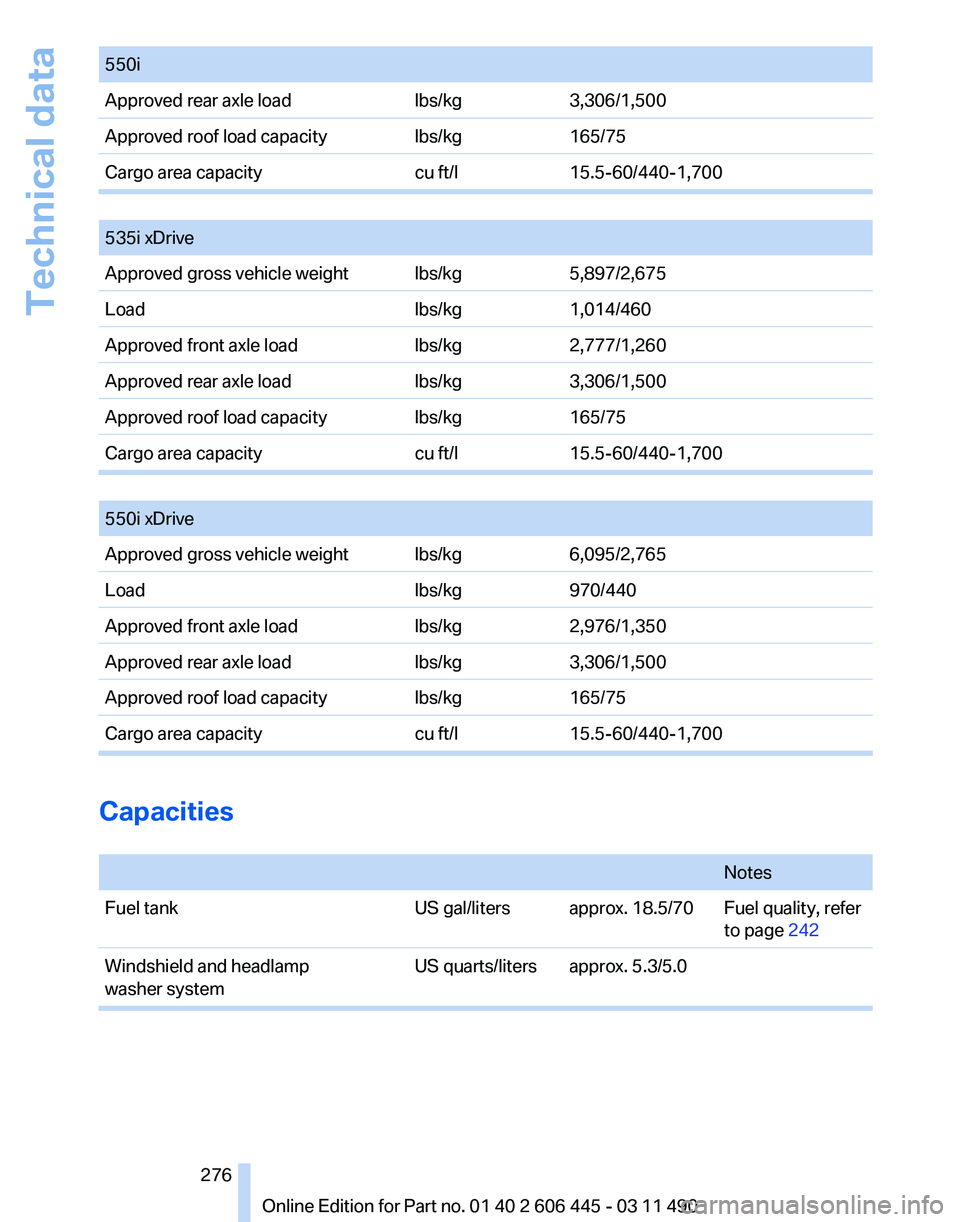
550i
Approved rear axle load
lbs/kg3,306/1,500
Approved roof load capacity lbs/kg165/75
Cargo area capacity cu ft/l15.5-60/440-1,700
535i xDrive
Approved gross vehicle weight lbs/kg
5,897/2,675
Load lbs/kg1,014/460
Approved front axle load lbs/kg2,777/1,260
Approved rear axle load lbs/kg3,306/1,500
Approved roof load capacity lbs/kg165/75
Cargo area capacity cu ft/l15.5-60/440-1,700
550i xDrive
Approved gross vehicle weight lbs/kg
6,095/2,765
Load lbs/kg970/440
Approved front axle load lbs/kg2,976/1,350
Approved rear axle load lbs/kg3,306/1,500
Approved roof load capacity lbs/kg165/75
Cargo area capacity cu ft/l15.5-60/440-1,700Capacities
Notes
Fuel tank US gal/liters approx. 18.5/70 Fuel quality, refer
to page 242
Windshield and headlamp
washer system US quarts/liters approx. 5.3/5.0 Seite 276
276 Online Edition for Part no. 01 40 2 606 445 - 03 11 490Technical data
Page 292 of 297
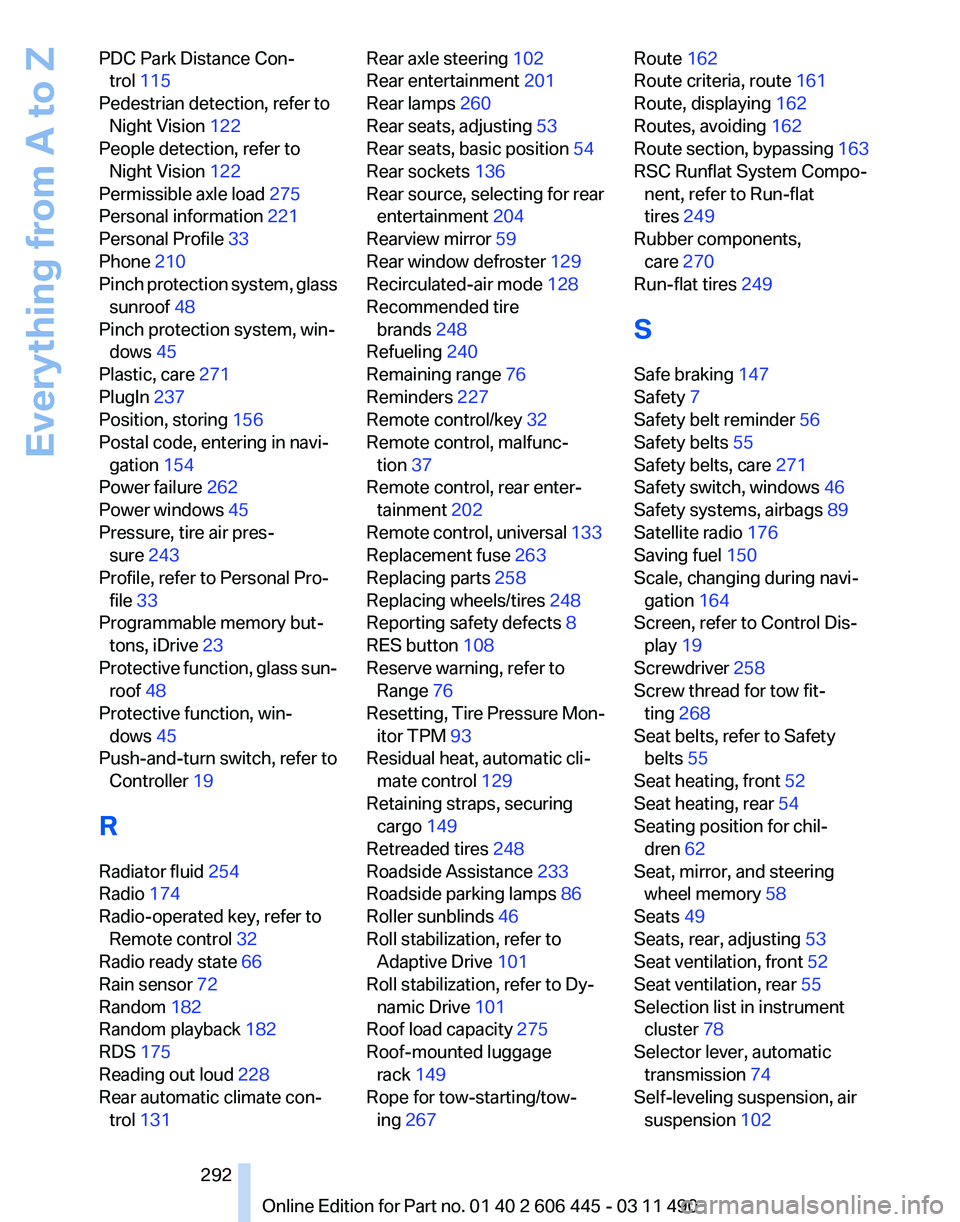
PDC Park Distance Con‐
trol 115
Pedestrian detection, refer to Night Vision 122
People detection, refer to Night Vision 122
Permissible axle load 275
Personal information 221
Personal Profile 33
Phone 210
Pinch
protection system, glass
sunroof 48
Pinch protection system, win‐ dows 45
Plastic, care 271
PlugIn 237
Position, storing 156
Postal code, entering in navi‐ gation 154
Power failure 262
Power windows 45
Pressure, tire air pres‐ sure 243
Profile, refer to Personal Pro‐ file 33
Programmable memory but‐ tons, iDrive 23
Protective function, glass sun‐ roof 48
Protective function, win‐ dows 45
Push-and-turn switch, refer to Controller 19
R
Radiator fluid 254
Radio 174
Radio-operated key, refer to Remote control 32
Radio ready state 66
Rain sensor 72
Random 182
Random playback 182
RDS 175
Reading out loud 228
Rear automatic climate con‐ trol 131 Rear axle steering 102
Rear entertainment 201
Rear lamps 260
Rear seats, adjusting
53
Rear seats, basic position 54
Rear sockets 136
Rear source, selecting for rear entertainment 204
Rearview mirror 59
Rear window defroster 129
Recirculated-air mode 128
Recommended tire brands 248
Refueling 240
Remaining range 76
Reminders 227
Remote control/key 32
Remote control, malfunc‐ tion 37
Remote control, rear enter‐ tainment 202
Remote
control, universal 133
Replacement fuse 263
Replacing parts 258
Replacing wheels/tires 248
Reporting safety defects 8
RES button 108
Reserve warning, refer to Range 76
Resetting, Tire Pressure Mon‐ itor TPM 93
Residual heat, automatic cli‐ mate control 129
Retaining straps, securing cargo 149
Retreaded tires 248
Roadside Assistance 233
Roadside parking lamps 86
Roller sunblinds 46
Roll stabilization, refer to Adaptive Drive 101
Roll stabilization, refer to Dy‐ namic Drive 101
Roof load capacity 275
Roof-mounted luggage rack 149
Rope for tow-starting/tow‐ ing 267 Route 162
Route criteria, route 161
Route, displaying
162
Routes, avoiding 162
Route
section, bypassing 163
RSC Runflat System Compo‐ nent, refer to Run-flat
tires 249
Rubber components, care 270
Run-flat tires 249
S
Safe braking 147
Safety 7
Safety belt reminder 56
Safety belts 55
Safety belts, care 271
Safety switch, windows 46
Safety systems, airbags 89
Satellite radio 176
Saving fuel 150
Scale, changing during navi‐ gation 164
Screen, refer to Control Dis‐ play 19
Screwdriver 258
Screw thread for tow fit‐ ting 268
Seat belts, refer to Safety belts 55
Seat heating, front 52
Seat heating, rear 54
Seating position for chil‐ dren 62
Seat, mirror, and steering wheel memory 58
Seats 49
Seats, rear, adjusting 53
Seat ventilation, front 52
Seat ventilation, rear 55
Selection list in instrument cluster 78
Selector lever, automatic transmission 74
Self-leveling suspension, air suspension 102
Seite 292
292 Online Edition for Part no. 01 40 2 606 445 - 03 11 490
Everything from A to Z